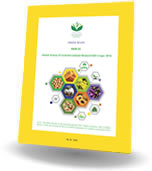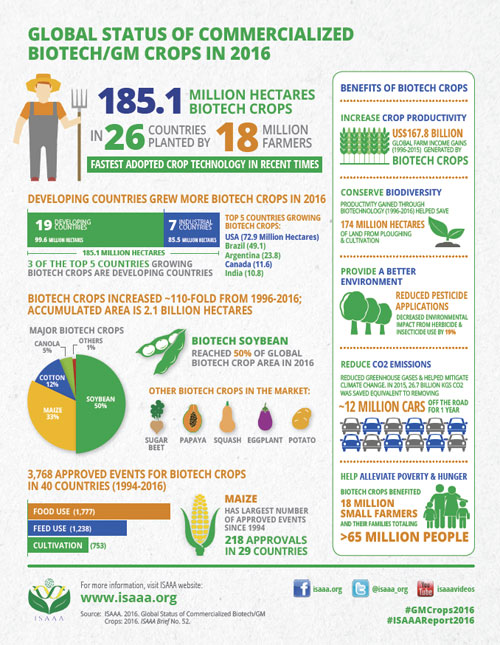Beijing, China
May 4, 2017

ISAAA Brief 52: Global Status of Commercialized Biotech/GM Crops: 2016
Today, the International Service for the Acquisition of Agri-biotech Applications (ISAAA) released its annual report showcasing the 110-fold increase in adoption rate of biotech crops globally in just 21 years of commercialization – growing from 1.7 million hectares in 1996 to 185.1 million hectares in 2016. ISAAA’s report, “Global Status of Commercialized Biotech/GM Crops: 2016,” continues to demonstrate the long-standing benefits of biotech crops for farmers in developing and industrialized countries, as well as consumer benefits of recently approved and commercialized varieties.
“Biotech crops have become a vital agricultural resource for farmers around the world because of the immense benefits for improved productivity and profitability, as well as conservation efforts,” said ISAAA Chair of the Board, Paul S. Teng. “With the commercial approvals and plantings of new varieties of biotech potatoes and apples, consumers will begin to enjoy direct benefits of biotechnology with produce that is not likely to spoil or be damaged, which in turn has the potential to substantially reduce food waste and consumer grocery costs.”

Examining other benefits of biotechnology, ISAAA reports that the adoption of biotech crops has reduced CO2 emissions equal to removing approximately 12 million cars from the road annually in recent years; conserved biodiversity by removing 19.4 million hectares of land from agriculture in 2015; and decreased the environmental impact with a 19% reduction in herbicide and insecticide use.1 Additionally, in developing countries, planting biotech crops has helped alleviate hunger by increasing the incomes for 18 million small farmers and their families, bringing improved financial stability to more than 65 million people.
“Biotechnology is one of the tools necessary in helping farmers grow more food on less land,” explained ISAAA Global Coordinator Randy Hautea. “However, the promises of biotech crops can only be unlocked if farmers are able to buy and plant these crops, following a scientific approach to regulatory reviews and approvals.”

As more varieties of biotech crops are approved and commercialized for use by farmers, ISAAA expects to see adoption rates continue to climb and to benefit farmers in developing countries. For example, among African nations where regulatory processes have traditionally created barriers to biotech crop adoption rates, advances are being realized. In 2016, South Africa and Sudan increased the planting of biotech maize, soybean and cotton to 2.66 million hectares from 2.29 million hectares in 2015. Elsewhere on the continent, a new wave of acceptance is emerging as Kenya, Malawi, Nigeria, Ethiopia, Ghana, Nigeria, Swaziland and Uganda make advances in regulatory review and commercial approvals for a variety of biotech crops.
“Even with a long history of regulatory barriers, African farmers continue to adopt biotech crops because of the value they are realizing from the stability and productivity of biotech varieties,” said Hautea. “As more countries move forward with regulatory reviews for crops such as bananas, cowpeas and sorghum, we believe biotech crop plantings will continue to grow in Africa and elsewhere.”
Also in 2016, Brazil increased biotech area of maize, soybean, cotton and canola by a remarkable 11% – maintaining its ranking as the second largest producer of biotech crops after the United States. In Brazil, biotech soybeans account for 32.7 million hectares of the 91.4 million hectares grown worldwide.
For 2016, ISAAA also reports that there were improvements in the commercialization and plantings of biotech fruits and vegetables with direct consumer benefits. These included the commercial approvals of the Innate™ Russet Burbank Gen 2 potatoes that were approved by the U.S. Food and Drug Administration for sale in the United States and the Simplot Gen 1 White Russet™ brand potatoes that were approved by Health Canada for fresh market sale in Canada. These biotech potato varieties have lower levels of asparagine, which reduces the creation of acrylamide during high-heat cooking. Additionally, the first commercially saleable quantities of Arctic® Apples were harvested in 2016, stored over the winter and are projected to be sold in U.S. grocery stores in 2017.
Additional highlights from ISAAA’s 2016 report include:
- Global area rebounded in 2016 with 185.1 million hectares of biotech crops versus 179. 7 million hectares 2015, when global area for all crops was down, and 181.5 million hectares in 2014.
- In 2016, 26 countries in total, including 19 developing and 7 industrial countries, grew biotech crops. Developing countries grew 54% of biotech crops, compared to 46% for industrial nations.
- Eight countries in Asia and the Pacific, including China and India, grew 18.6 million hectare of biotech crops in 2016.
- 10 countries in Latin America, including Paraguay and Uruguay, grew a combined 80 million hectares of biotech crops in 2016.
- In 2016, the leading countries growing biotech crops continued to be represented by the United States, Brazil, Argentina, Canada and India. Combined, these five countries planted 91% of the global biotech crop area.
- Four countries in Europe -- Spain, Portugal, Czech Republic Slovakia -- grew more than 136,000 hectares of biotech maize in 2016, an increase of 17% from 2015, reflecting EU’s need for insect resistant maize.
- Biotech crops with stacked traits accounted for 41% of global area, second only to herbicide tolerance at 47%.
- Biotech soybean varieties accounted for 50% of global biotech crop area. Based on global area for individual crops, 78% of soybean, 64% of cotton, 26% of maize and 24% of canola planted in the world were biotech varieties.
- Countries with over 90% adoption of biotech soybean are U.S.A, Brazil, Argentina, Canada, South Africa, and Uruguay; close to or over 90% adoption of biotech maize are USA, Brazil, Argentina, Canada, South Africa, and Uruguay; over 90% of biotech cotton are USA, Argentina, India, China, Pakistan, South Africa, Mexico, Australia, and Myanmar; and with 90% or more of biotech canola are USA and Canada.
For more information or the executive summary of the report, visit www.isaaa.org.
ISAAA Brief 52-2016: Contents
Global Status of Commercialized Biotech/GM Crops: 2016
- List of Tables and Figures
- Introduction
- Global Area of Biotech Crops in 2016
- Distribution of Biotech Crops in Industrial and Developing Countries
- Distribution of Biotech Crops, by Country
- Economic Benefits of Biotech Crops
- Country Chapters
- United States of America
- Brazil
- Argentina
- Canada
- India
- Paraguay
- China
- Pakistan
- South Africa
- Uruguay
- Latin American Countries
- Bolivia
- Mexico
- Colombia
- Honduras
- Chile
- Costa Rica
- Future Prospects for Latin America
- Asia and the Pacific
- Australia
- Philippines
- Myanmar
- Vietnam
- Bangladesh
- Future Prospects of Biotech Crops in Asia and the Pacific
- The European Union (EU 28)
- Spain
- Portugal
- Slovakia
- Czech Republic
- Need for EU to Change Stance on Biotech Crops
- United Kingdom's Exit (BREXIT) from the EU Could Open GM Opportunities
- Benefits of Biotech Crops
- Future Prospects of Biotech Crops in the EU
- Africa
- Progress with Biotech Crops Research in Other African Countries
- Biosafety Policy Developments
- Technology Demand
- Partnerships Emerging in Africa
- Policy Pronouncements
- Distribution of Biotech Crops, by Crop
- Biotech soybean
- Biotech maize
- Biotech cotton
- Biotech canola
- Biotech alfalfa
- Other biotech crops
- Distribution of Biotech Crops, by Trait
- The Global Value of the Biotech Crop Market
- Trends in Biotech Crop Approvals 1992-2016
- Benefits of Biotech/Genetically Modified Crops
- Future of Biotech Crops: A Game Changer
- Biotech/GM Crop Regulation Supportive of Innovation
- Conclusion and Closing Comments
- References
- Appendices
1Brookes and Barfoot, 2017, Forthcoming